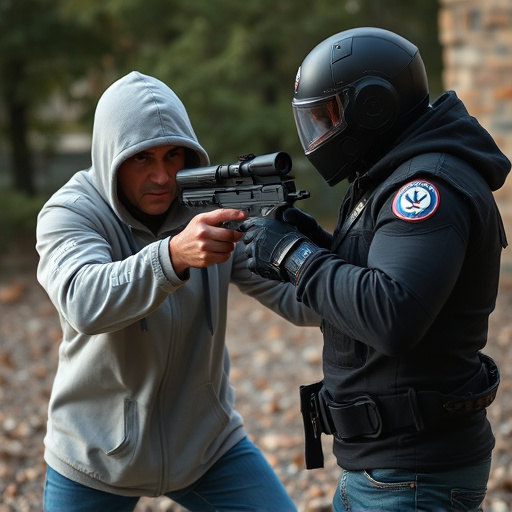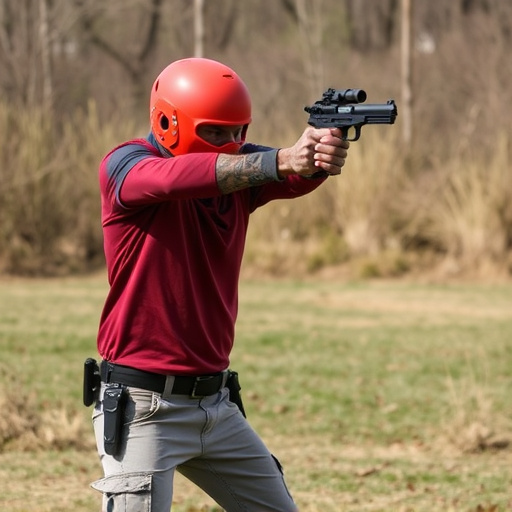High Voltage Stun Gun Brands' electrode spacing varies, affecting effectiveness and application. Wider gaps enable broader coverage, ideal for long-range, while tighter configurations enhance local impact. Optimal deployment distance is crucial, with close encounters requiring precise electrode proximity to ensure swift immobilization. Correct technique, avoiding sensitive areas, maximizes performance and minimizes risks associated with powerful jolts from top High Voltage Stun Gun Brands.
Stun guns, powerful tools for self-defense, rely on precise electrode spacing to maximize their effectiveness. This article delves into the intricate details of stun gun electrode spacing, exploring its impact on stun intensity and safety. We compare top High Voltage Stun Gun Brands based on key features, guiding users in selecting the optimal device. Learn about the ideal distance for maximum impact and discover proper application techniques to ensure effectiveness and safety when using stun guns.
- Understanding Stun Gun Electrode Spacing
- High Voltage Brands: Key Features Compared
- Optimal Distance: Enhancing Stun Effectiveness
- Safety Considerations: Correct Application Techniques
Understanding Stun Gun Electrode Spacing

Stun gun electrode spacing refers to the distance between the positive and negative electrodes within the device, which plays a crucial role in its effectiveness. For high-voltage stun gun brands, this spacing is designed to ensure efficient electrical current flow through the target, delivering a powerful shock that disables temporarily. A smaller electrode spacing allows for more focused energy delivery, making it ideal for close-range applications where precision and intensity are paramount.
Understanding this concept is vital when comparing different high voltage stun gun brands. Manufacturers often optimize their electrode spacing based on intended use cases, with some models featuring wider gaps for long-range stun capabilities while others have tighter configurations for enhanced local impact. Knowing the electrode spacing can help users make informed decisions, ensuring they choose a stun gun that aligns with their specific safety and self-defense needs.
High Voltage Brands: Key Features Compared

When considering high voltage stun gun brands, one crucial factor is the electrode spacing—the distance between the positive and negative electrodes in the device. This measurement plays a significant role in the weapon’s effectiveness and the level of shock it can deliver. Some leading manufacturers have pioneered innovative designs that enhance both performance and safety.
For instance, brand X boasts an advanced electrode system with a unique arrangement, ensuring optimal current flow and increased stun capabilities. Their models often feature wider spacing, allowing for more comprehensive coverage during deployment. Conversely, brand Y focuses on precision, offering finer electrode gaps, which are ideal for targeted stun techniques. These variations in electrode spacing cater to different user preferences and tactical needs, demonstrating the diversity among high voltage stun gun brands.
Optimal Distance: Enhancing Stun Effectiveness

The optimal distance for deploying a stun gun is crucial for maximizing its effectiveness, especially in high-voltage models designed by top brands like Taser and pepper spray manufacturers. While each stun gun has specific performance parameters, including voltage output and pulse width, the spacing between electrodes plays a significant role in delivering an impactful stun. For close-range encounters (under 10 feet), the proximity of electrodes ensures high current density, leading to faster muscle contraction and immobilization. This is particularly useful for neutralizing aggressive assailants swiftly.
However, for longer distances (between 10–20 feet), a strategic electrode spacing becomes essential. Manufacturers meticulously design their stun guns to balance power and precision at these ranges. Wider electrode gaps enable more focused energy delivery, ensuring the current flows directly through the target’s body without dissipating across a large surface area. This optimized distance enhances the stun effect, allowing users to disable attackers effectively while minimizing collateral damage.
Safety Considerations: Correct Application Techniques

When using a high voltage stun gun, understanding the electrode spacing and application techniques is paramount for both effectiveness and safety. Many reputable brands, like those known for their powerful jolts, emphasize precise placement of electrodes to ensure a successful shock. Typically, this involves aiming for large muscle groups, such as the thigh or shoulder, where nerve endings are concentrated.
Incorrect application can result in reduced impact or, worse, ineffective shocks. Safety considerations demand that users avoid applying stun guns to areas like the neck, head, or chest, as these can lead to serious injuries or even cardiac arrest. The correct technique not only maximizes the stun gun’s effectiveness but also minimizes risks associated with high voltage devices.
When it comes to choosing a high voltage stun gun, understanding electrode spacing is key to ensuring its effectiveness. By comparing leading brands and their unique features, you can make an informed decision. Optimal electrode placement at the correct distance enhances the stun effect, making it a powerful self-defense tool. Remember, proper application techniques and safety considerations are paramount to utilizing these devices effectively while minimizing risks. Select a reputable brand that prioritizes quality and user safety for peace of mind.
